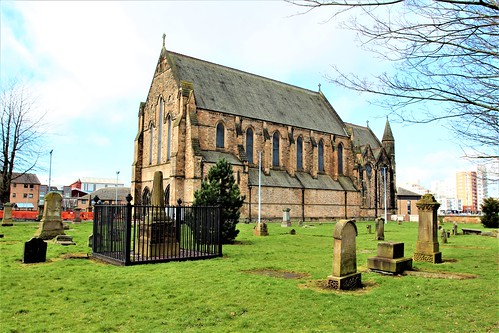Walk Glasgow Waterfront
(Above image is a capture of Spring flowers at Blythswood Square in Glasgow.)
This morning I went into Glasgow to view an exhibition of landscape photographic images by a high profile photographer. Unfortunately, I was distinctly unimpressed with the quality of the work and resolved to walk along the banks of the River Clyde to the former shipbuilding centre of Govan, a distance of about three miles.
The walk to Govan proved very satisfying allowing me to connect with a wide range of architecture and scenes, as illustrated below, culminating in an unexpected bonus of archaeology in process at the burial ground of Govan Old Parish Church.
Notwithstanding temperature at just above freezing, the weather remained reasonably benign and favourable for photography.
Broomielaw-Tradeston Bridge aka 'Squiggly Bridge': For pedestrians.
Elaborate architecture from 1903: The Kingston Halls included a public library funded by philanthropist, Andrew Carnegie.
The Clyde Arc or 'Squinty' Bridge which dates from 2006.
Finnieston Crane: This dates from 1932 but is no longer in use. It was erected to transfer Glasgow manufactured steam engines into the holds of ships for export.
Paddle Steamer 'Waverley':This dates from 1946 and is still used for pleasure trips.
Govan Town Hall:This dates from 1897-1901 and is built in the French neo-classical style.Now used as a production and media base for Scotland's burgeoning film industry.
Science Centre Tower: This is the only structure on earth capable of rotating 360° into the prevailing wind and holds the Guinness World Record for the tallest fully rotating freestanding structure in the world. At 127 metres (416 feet) high the Tower is the tallest freestanding building in Scotland.
Glasgow Science Centre : This offers science based learning facilities mainly targeted at school age students.
Here are the derelict Govan Graving Docks, now abandoned, which date from 1875 when Glasgow was a world leader in shipbuilding. The site has been abandoned for many years and, bizarrely, despite this country's obsession with health and safety, is effectively open to anyone who wishes to wander in and look around. What looks like a site for horror movie is now going to be turned into one as there are media reports of a big-budget WW1 film using the location for certain sequences.Upside of the filming is that the site will be cleared of garbage, graffiti, etc.
Tall ship 'Glenlee' moored outside the Riverside Museum. Latter is focused on transport. The Glenlee is a restored, steel-hulled, three masted barque built at Glasgow in 1896.
At end of my walk I called in at Govan Old Parish Church for a photograph and was pleasantly surprised to find a large team of local people with qualified archaeologists at work revealing long lost tombstones. Although the current church on the site is Victorian it is the the third or fourth such place of worship on the site which dates back to around the 6th century when Christianity was first introduced to Scotland. This church is home to a large collection of elaborately carved grave markers and a stone sarcophagus which collectively are known as the Govan Carved Stones and date from around the ninth century when Govan was an important power centre, pre-dating Glasgow.
Revealing a buried tombstone, undated, but probably from the late 1700s.
Archaeology in process at Govan Old Parish Church
Govan old Parish Church and Burial Ground.
Final call was to the local branch of food chain Greggs to sample the vegan sausage rolls which have become all the rage of late and influenced a near 100pct rise in Greggs share price over the past 12 months. Taste was 'OK' and possibly needs to be acquired.
Greggs vegan sausage rolls (top shelf).
















Comments
Post a Comment